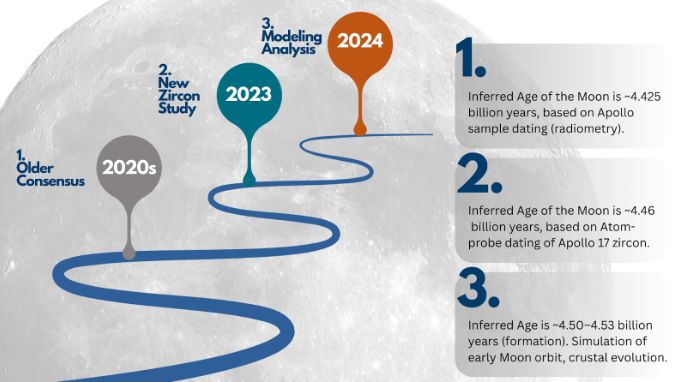The moon lives in pop culture, but science questions how young we are today
Clarence Oxford
Los Angeles CA (SPX) June 15, 2025
For decades, scientists have thought that the moon was formed around 4.4 billion to 4.5 billion years ago. Perhaps in the aftermath of a Titanic collision between a young Earth and a Mars-sized object (the famous giant impact hypothesis). However, exactly when the birth of that month happened remains difficult to pin. In fact, modern science is now questioning the “young people” of the moon. It suggests that our moon companions may be older than previously believed.
It’s growing cultural presence
The mystery of the moon is not limited to science – it is also deeply woven into pop culture. You can see the moon’s influence in films, music, folklore, and even video games. One impressive example is the popularity of moon-themed games in the booming online gaming industry. There are so many examples, but one game called “Moon Sisters” is very typical, showing how recent moon images and legends attract players.
The Joe Fortune platform slot games have symbols such as butterflies, lotus flowers, and classic play card icons. Importantly, the symbolism of the moon becomes a central setting. Koi fish acts as a symbol of the wild (an auspicious icon to replace other symbols), and the glowing moon bonus symbol causes special rewards. For example, if you land six or more moon symbols, a bonus round of the reel will stick to the reel and reset the respin count. This gameplay – a promising payment that leaves players on the moon – shows how the image of the moon evokes excitement and wonder.
Why are you themed around the moon games? Because the moon carries a rich cultural association. It means mystery, romance and luck in many cultures – the emotions that game designers energize to captivate their audience. The phrase “over the moon” (meaning extremely happy) shows how ingrained the image of the moon is, which has soaked into our language. By portraying the enduring charm of the moon, pop culture products like Moon Sisters resonate with people’s imaginations. In a broader sense, this reflects how deeply the moon lives in modern culture.
Is the moon older than we thought?
In 2023, the research team used state-of-the-art atomic probe tomography techniques to measure uranium decay, leading lead into these minimal crystals, and determined their age. The results surprised researchers: One month’s zircon crystal revealed an age of around 4.46 billion. This was about 40 million years or more than previous estimates, and was monthly age (previously thought to be around 4.42 billion).
This kind of evidence has led scientists to readjust their moon timelines. “We cannot always use the age recorded on the rocks to know when the moon formed,” says Francis Nemo, a planetary scientist who leads a recent study. In other words, the age of surface rocks (even if they are very old) does not always reveal the true date of formation. That’s because the surface of the moon has overcome many confusions that allow you to erase or reset your geological clock. Many of the moon rocks brought back by Apollo turned out to be about 4.35 billion years ago. Why is there a contradiction? Scientists now suspect that the dramatic events “rimmelted” most of the crust around 4.35 billion years ago after the moon first formed.
To summarise some important findings regarding the age of a month, consider the following timeline for scientific estimation:

These findings answer the questions in the title. Modern science raises doubts the young people of the moon by showing that it is older than we thought. Rather than a slow addition to the solar system, the moon may have been around from the beginning – not a young brother of Earth, but a venerable elder.
The exploration of the moon and the ongoing mysteries
Despite these advances, scientists still have many questions about the early days of the moon – and new missions are on the horizon to help answer them. Each discovery appears to be raising a fresh puzzle. To dig deeper (literally) deeper, space agencies around the world are preparing for the next phase of lunar exploration.
NASA’s Artemis program is trying to bring humans back to the moon and collect new samples from areas that have never been to before, including the Antarctic on the moon. By analyzing these samples with today’s ultra-sensitive instruments, scientists hope to further improve their estimation of the age of the month, and perhaps capture traces of those primitive events. In particular, NASA recently opened a sealed Apollo sample from 50 years ago that was preserved at this moment. This is a practice run to help you maximize science from the Artemis sample returns.
In addition to retrieving samples, Orbiters and Rovers can help you learn more about the Moon. Today’s lunar orbit can be looked at what the surface is made of, or use gravity data to see inside the moon, giving clues as to how it was formed. At the same time, scientists are running more advanced simulations of what the early Earth Moon system looked like. Whether it’s an accurate rock age or a detailed gravity map, each of the new data helps us to better understand how the moon has changed over time.
Related links
Space tourism, space transport, space exploration news


